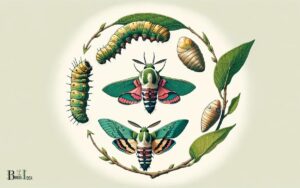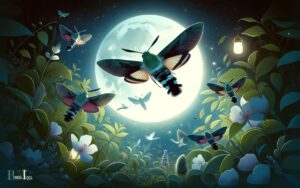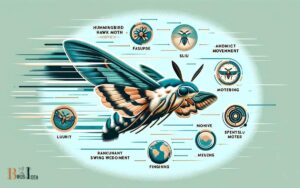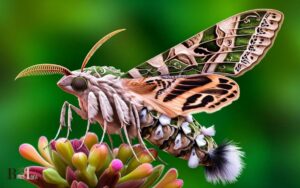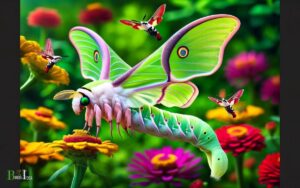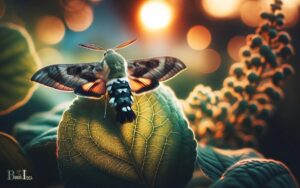Are Hummingbird Moths Good or Bad? Find Out!
Hummingbird moths are beneficial insects in the ecosystem. They are important pollinators for many flowering plants and do not pose any significant threat to gardens or natural habitats.
Hummingbird moths, often mistaken for their avian namesakes, are actually positive contributors to their environments. They play a crucial role in pollination, similar to bees and butterflies.
Here are key points about their impact:
Hummingbird moths are delightful garden visitors, whose pollination efforts support the health of many plant species.
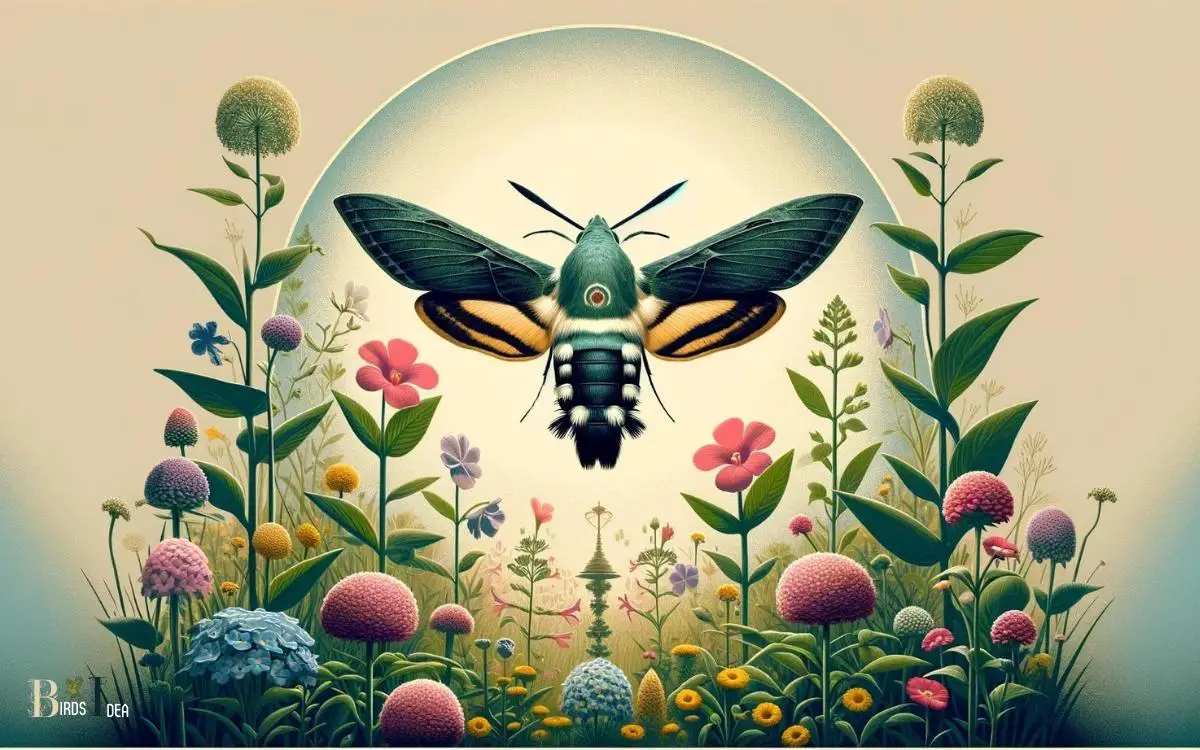
Key Takeaway
The Ecological Role of Hummingbird Moths in Gardens
| Aspect | Detail |
|---|---|
| Scientific Name | Hemaris thysbe (Common Hummingbird Moth) |
| Habitat | Meadows, gardens, forest edges, and suburban areas |
| Diet | Primarily nectar from a variety of flowers |
| Pollination | Effective at pollinating due to their size and behavior of hovering like hummingbirds |
| Lifecycle | Four stages: egg, larva (caterpillar), pupa (chrysalis), and adult (moth) |
| Benefit to Gardens | Pollinate flowers, contributing to the health and beauty of the garden ecosystem |
| Environmental Role | Serve as pollinators and as prey for other species, thus are an integral part of food chains |
| Potential Concerns | Larvae may feed on leaves of specific host plants, but rarely in damaging amounts |
Physical Characteristics
The hummingbird moth’s physical characteristics closely resemble those of a hummingbird. With a wingspan of about 1.6 to 1.8 inches, the moth has large, transparent wings that beat rapidly, allowing it to hover in front of flowers to feed on nectar.
Its body is stout and often covered in fur-like scales, usually olive green or brown, resembling the coloration of a hummingbird.
The long proboscis, similar to that of a hummingbird, is used to reach deep into flowers to extract nectar.
Like a hummingbird, the moth’s flight is quick and agile, enabling it to dart from one flower to another with remarkable precision.
These physical similarities between the hummingbird moth and the hummingbird aren’t just coincidental but are evolutionary adaptations that serve similar ecological roles.
Life Cycle
During their life cycle, hummingbird moths undergo a complete metamorphosis, transitioning through four distinct stages: egg, larva, pupa, and adult.
The life cycle begins with the female moth laying eggs on suitable host plants, such as honeysuckle or hollyhock.
Once hatched, the larvae, often referred to as hornworms due to their horn-like protrusions, voraciously consume leaves and stems.
After undergoing several molts, the larvae enter the pupal stage, where they encase themselves in a cocoon or burrow into the soil to undergo metamorphosis.
In this stage, they undergo significant changes and eventually emerge as adult moths. The adult stage is dedicated to reproduction, and the cycle repeats.
This remarkable transformation allows hummingbird moths to adapt to their environment and fulfill their ecological role as pollinators.
Role in Pollination
Hummingbird moths play a crucial role in pollination, much like bees. As they feed on nectar from flowers, they inadvertently transfer pollen from one flower to another, aiding in the process of cross-pollination.
This process is essential for the reproduction of many plant species and contributes to the overall health and diversity of ecosystems.
Pollinate Like Bees
Like bees, hummingbird moths play a crucial role in pollinating a wide variety of flowers. These moths are important pollinators, transferring pollen from one flower to another as they feed on nectar.
Their long proboscis allows them to reach deep into flowers, making them effective pollinators for plants with long tubular blooms.
As they move from flower to flower, they inadvertently carry pollen on their bodies, facilitating the fertilization of plants.
This process is essential for the reproduction of many plant species and contributes to the overall health and diversity of ecosystems.
Hummingbird moths exhibit behaviors similar to bees during pollination, and their role in this process highlights their significance in maintaining the delicate balance of natural ecosystems.
Cross-Pollination Benefits Plants
Cross-pollination benefits plants by ensuring genetic diversity and promoting robust growth. When plants receive pollen from another plant, it results in the production of seeds with diverse genetic traits.
This genetic diversity is essential for the adaptation and survival of plant species, especially in changing environmental conditions.
Cross-pollination also leads to increased fruit and seed production, contributing to the overall health of plant populations.
Additionally, it promotes the creation of hybrid plants with unique and potentially beneficial characteristics.
Overall, cross-pollination plays a crucial role in the reproductive success and long-term survival of plant species.
- Genetic diversity enhances resilience
- Increased fruit and seed production
- Creation of unique hybrid plants
- Essential for plant adaptation
- Promotes long-term survival
Essential for Ecosystems
The role of pollinators in ecosystems is essential for ensuring the continued transfer of genetic material between plant species, thereby maintaining genetic diversity and promoting the overall health and resilience of plant populations.
Hummingbird moths play a crucial role in pollination as they visit various flowers to feed on nectar, inadvertently transferring pollen from one flower to another.
This process is vital for the reproduction of many plant species, ensuring the production of seeds and the continuation of plant populations.
Without pollinators like the hummingbird moth, many plant species would struggle to reproduce and maintain their numbers, ultimately impacting the entire ecosystem.
Therefore, the presence of hummingbird moths and their contribution to pollination is instrumental in sustaining the balance and biodiversity of ecosystems.
Impact on Garden Plants
Hummingbird moths play a crucial role in pollination, benefiting garden plants by transferring pollen from one flower to another.
However, their larvae can cause damage to garden plants by feeding on their leaves. Additionally, hummingbird moths have varied feeding preferences, which may impact different types of garden plants in different ways.
Larvae May Damage
Larvae of hummingbird moths can damage garden plants by consuming foliage and causing defoliation, potentially impacting the plants’ overall health and growth.
The larvae, also known as hornworms, are voracious feeders and can quickly strip leaves from plants such as tomatoes, peppers, and petunias.
This defoliation can weaken the plants, making them more susceptible to other stresses such as drought or disease.
While some gardeners may find the larvae destructive, it’s important to note that the damage is usually localized and doesn’t typically lead to widespread plant loss.
However, in cases of heavy infestation, gardeners may need to take action to control the larvae to prevent significant damage to their garden plants.
Understanding the potential impact of hummingbird moth larvae on garden plants can help gardeners make informed decisions about managing these insects.
Varied Feeding Preferences
One may notice that hummingbird moth larvae exhibit varied feeding preferences, impacting a range of garden plants with their voracious appetites.
These preferences can have a significant impact on the overall health and appearance of a garden.
Some plants may be more susceptible to damage from hummingbird moth larvae than others, leading to potential imbalances in the garden ecosystem.
The following are some observations regarding the impact of varied feeding preferences on garden plants:
- Certain plants may serve as preferred food sources, leading to potential damage.
- The larvae’s feeding behavior can affect the aesthetic appeal of the garden.
- Gardeners may need to implement strategies to protect susceptible plants from larval feeding.
- The impact of varied feeding preferences highlights the complex interactions between moths and garden plants.
- Understanding these preferences can aid in making informed decisions about plant selection and garden management.
Predation and Threats
Hummingbird moths face predation and threats from various predators, including birds, spiders, and other insects. Birds such as warblers, flycatchers, and orioles are known to prey on hummingbird moths.
These avian predators are attracted to the moths due to their conspicuous diurnal behavior and slow flight, making them vulnerable to bird attacks.
Additionally, spiders pose a threat to hummingbird moths, as they can ambush them in their intricate webs.
Other insects, such as predatory wasps and mantises, also target hummingbird moths for food.
These diverse predators have evolved various strategies to capture hummingbird moths, posing significant threats to their survival.
Despite their remarkable agility and mimicry, hummingbird moths must constantly contend with the risk of predation from a range of adversaries in their natural habitats.
Conservation Status
Facing numerous predators and threats in their natural habitats, hummingbird moths are currently facing a concerning conservation status due to habitat loss and pesticide use. Their populations are declining, raising alarms among conservationists and researchers.
Factors contributing to their conservation status include:
- Habitat Loss: The destruction and fragmentation of their natural habitats due to human activities are reducing their available resources.
- Pesticide Use: Exposure to pesticides is harming hummingbird moths directly or indirectly through the decline of their food sources.
- Climate Change: Shifts in climate patterns are affecting the availability of nectar-producing flowers, crucial for their survival.
- Invasive Species: Competition with invasive species for food and habitat is putting additional pressure on their populations.
- Lack of Awareness: Many people are unaware of the significance of hummingbird moths, leading to a lack of conservation efforts.
These factors highlight the urgent need for conservation measures to protect these fascinating creatures.
:Are Hummingbird Moths Harmful and Should I Get Rid of Them?
Hummingbird moths are actually beneficial garden visitors. They don’t harm plants and flowers, and they’re great pollinators. However, if you feel the need to get rid of them, there are several methods for eliminating hummingbird moths, such as using insecticides or setting up traps to capture them.
Coexistence With Humans
The coexistence of hummingbird moths with humans presents challenges and opportunities for both species. Hummingbird moths play a vital role in pollination, benefiting plant life and agriculture.
However, their presence near human habitats can lead to conflicts, particularly in agricultural settings where their larvae may feed on valuable crops.
On the other hand, these moths also bring opportunities for scientific study and ecotourism. Observing their behavior in urban and suburban areas can provide valuable insights into their adaptability and the health of local ecosystems.
The following table summarizes the key points regarding the coexistence of hummingbird moths with humans:
| Aspect | Challenges | Opportunities |
|---|---|---|
| Agricultural Impact | Larvae feeding on crops | Pollination benefits, scientific study |
| Human Interaction | Potential conflicts | Ecotourism, educational opportunities |
| Ecosystem Health | Impact on local flora and fauna | Indicators of ecosystem health, adaptability study |
Conclusion
The hummingbird moth is a fascinating creature that plays a valuable role in pollination and contributes to the beauty of the natural world.
Its delicate appearance and graceful flight can be compared to the poetry of nature, inviting us to appreciate the interconnectedness of all living things.
As we continue to coexist with these remarkable creatures, it’s important to appreciate and protect their presence in our gardens and ecosystems.

